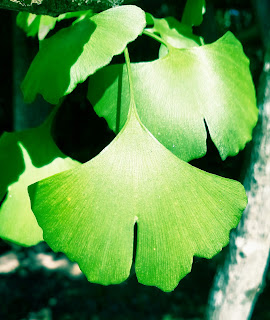I read The Whispering Leaves of the Hiroshima Ginkgo Trees in the New York Times last week. The piece reminded me that the ginkgo has been found in fossils over 270 million years old. Ginkgo trees are survivors, and the author is right that they might have a message for us.
Now, I look at the ginkgo tree outside the kitchen window with more reflection and ever more appreciation. I have always loved the leaves which turn a beautiful golden yellow in the fall. Moreover, the tree still brings me back to Goethe, the writer of classical German literature and poetry, who wrote so eloquently about the leaves of this woody perennial plant in the poem Ginkgo Biloba.
I had to memorize the poem and share an analysis of its meaning in a class I took during my junior year abroad at Albert Ludwigs Universitaet of Freiburg, Germany. The course was on the classicists, Goethe and Schiller, and was taught by a professor who had escaped East Germany. The class (taught completely in German) of American students was both intimidated and enamored with the professor. He was brilliant, had been a world class athlete, and epitomized the romantic notions of a worldly professor, who modeled silk scarves, recited literature, and wore an air of mystery. I mean, he had lived on the other side of the wall, and he had escaped.
In our extensive discussion about the course and the man outside of class, we jokingly called him Herr Gorbachev. And, in my nervous state during my presentation, I called him Herr Gorbachev to his face which resulted in peels of laughter from the rest of the class and my face washing in a deep shade of red. Clearly, he laughed it off as well as I remember scoring well on my work and the course.
Like the Hiroshima Ginkgo trees, I realize that Ginkgo Biloba taught me many things. It immersed me deeper into my love of poetry and strengthened my public speaking skills -- in a second language, no less. It helped me see two sides to a person, a piece of writing, an issue and an experience. It reminded me that humans are multifaceted, complicated beings and barriers are best torn down not erected.
When we read deeply or travel broadly or interact with the once unknown, we see ourselves from where we were before the experience and then again after -- we can be the same person yet different if only we open ourselves to the process and the journey. A small leaf and a short poem remind me that writing and nature can survive to travel over time and distance and cultural/lingual differences and help us see ourselves and our surroundings anew. Every time I see a Ginkgo tree, I say to myself, "Daß ich eins und doppelt bin?" Those are the words that return to me over and over, etched in my mind and retrieved involuntarily. And, I couldn't be more grateful for their insight.
GINKGO BILOBA
Johann Wolfgang von Goethe
German:
Dieses Baums Blatt, der von Osten
Meinem Garten anvertraut,
Gibt geheimen Sinn zu kosten,
Wie's den Wissenden erbaut.
Ist es ein lebendig Wesen,
Das sich in sich selbst getrennt?
Sind es zwei, die sich erlesen,
Daß man sie als eines kennt?
Solche Fragen zu erwidern
Fand ich wohl den rechten Sinn:
Fühlst Du nicht an meinen Liedern,
Daß ich eins und doppelt bin?
Meinem Garten anvertraut,
Gibt geheimen Sinn zu kosten,
Wie's den Wissenden erbaut.
Ist es ein lebendig Wesen,
Das sich in sich selbst getrennt?
Sind es zwei, die sich erlesen,
Daß man sie als eines kennt?
Solche Fragen zu erwidern
Fand ich wohl den rechten Sinn:
Fühlst Du nicht an meinen Liedern,
Daß ich eins und doppelt bin?
English:
In my garden’s care and favour
From the East this tree’s leaf shows
Secret sense for us to savour
And uplifts the one who knows.
Is it but one being single
Which as same itself divides?
Are there two which choose to mingle
So that each as one now hides?
As the answer to such question
I have found a sense that’s true:
Is it not my songs’ suggestion
That I’m one and also two?
~ Translated by John Whaley
